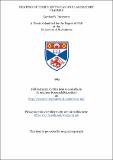Files in this item
Heating of turbulent solar and laboratory plasmas
Item metadata
| dc.contributor.advisor | Priest, E. R. (Eric Ronald) | |
| dc.contributor.author | Inverarity, Gordon W. | |
| dc.coverage.spatial | 212 p. | en_US |
| dc.date.accessioned | 2018-06-18T08:29:32Z | |
| dc.date.available | 2018-06-18T08:29:32Z | |
| dc.date.issued | 1995 | |
| dc.identifier.uri | https://hdl.handle.net/10023/14146 | |
| dc.description.abstract | The model of Heyvaerts and Priest (1992) for steady-state heating of the turbulent medium within a sheared solar coronal arcade structure is here developed. The energy input into the corona is calculated at the large scales of the model. At the smaller scales the effects of coronal turbulence are modelled in the form of an enhanced turbulent viscosity and magnetic diffusivity, which are related to the injected power density in the steady state. Matching the expressions for the injected and dissipated power enables the calculation of a heating power consistent with both boundary motions and turbulent effects with a minimum of arbitrary parameters - the price to be paid is that the inertial range spectrum must be prescribed and imposed at all scales. While it is capable of reproducing the observed levels of coronal heating (300 Wm⁻² 3x10⁵ erg cm⁻² s⁻ⁱ for the quiet Sun, 800 Wm⁻² (8 x 10⁵ erg cm⁻² s⁻ⁱ) for a coronal hole and 10⁴ Wm ⁻² (10⁷ erg cm⁻² s⁻ⁱ) for an active region (Withbroe and Noyes, 1977)), there are some mathematical and physical difficulties present. These are eliminated as far as is possible and it is found that the final results for heating levels differ little from the original model although there is a much greater consistency between the imposed and predicted energy power spectra. The modified approach is applied to the problems of photospheric motions twisting a coronal flux tube and of rapid motions injecting Alfven waves into an arcade. In the former case comparable levels of heating are obtained. For a driven and damped standing wave, however, desired levels of heating are only obtained when a global resonance occurs. Attempts are also made to find similar steady-state equilibria possessing flow for fusion experiments in order to apply the above procedure to investigate turbulence in laboratory plasmas. This has been hampered by the difficulty in finding simple appropriate equilibria with many scales present. | en_US |
| dc.language.iso | en | en_US |
| dc.publisher | University of St Andrews | en |
| dc.subject.lcc | QA927.I6 | |
| dc.subject.lcsh | Magnetohydrodynamics | en |
| dc.title | Heating of turbulent solar and laboratory plasmas | en_US |
| dc.type | Thesis | en_US |
| dc.contributor.sponsor | Science and Engineering Research Council (SERC) | en_US |
| dc.contributor.sponsor | Particle Physics and Astronomy Research Council (PPARC) | en_US |
| dc.contributor.sponsor | AEA Technology Culham | en_US |
| dc.type.qualificationlevel | Doctoral | en_US |
| dc.type.qualificationname | PhD Doctor of Philosophy | en_US |
| dc.publisher.institution | The University of St Andrews | en_US |
This item appears in the following Collection(s)
Items in the St Andrews Research Repository are protected by copyright, with all rights reserved, unless otherwise indicated.

